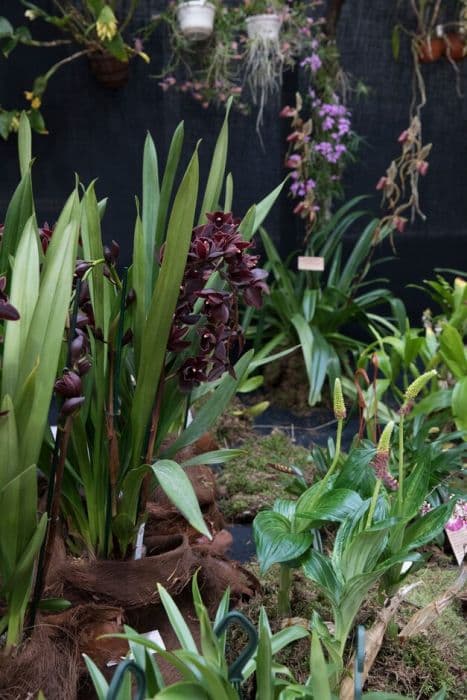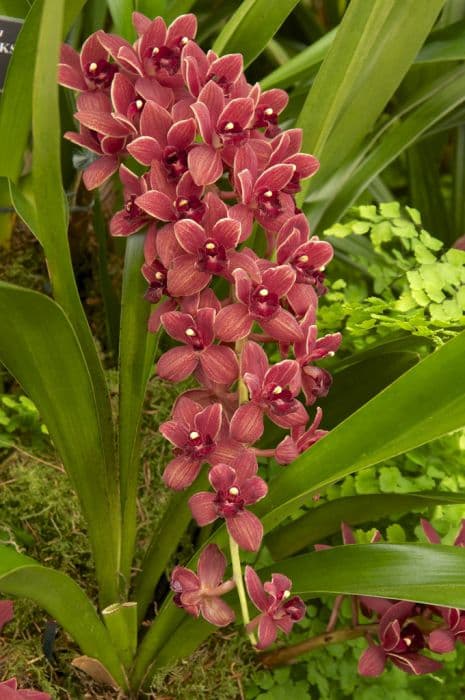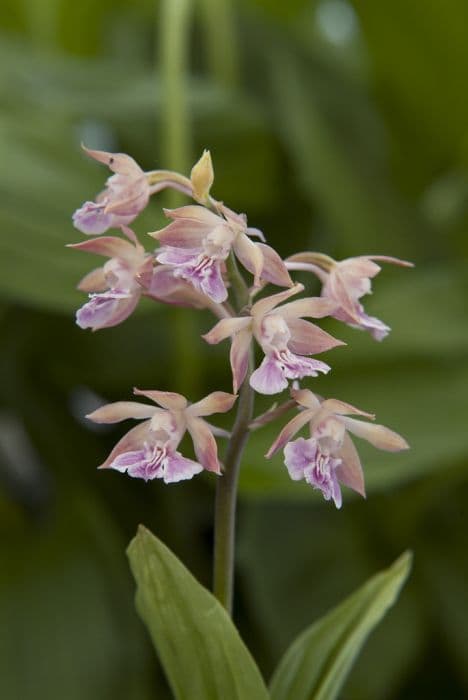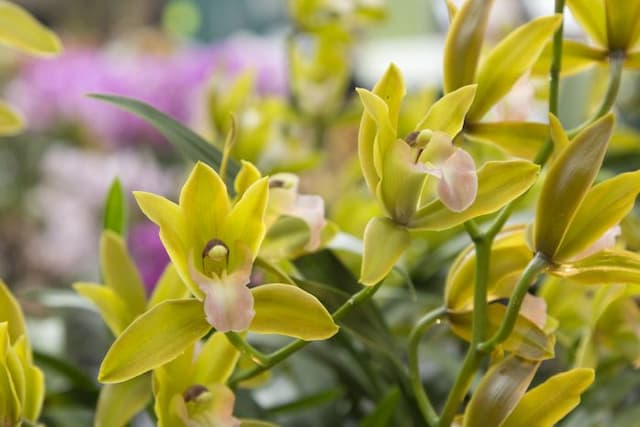Lady's Slipper Cypripedium × ventricosum

ABOUT
The plant commonly known as "Slipper Orchid" is a visually striking and ornamental flower. It typically bears a unique pouch-like petal that resembles a slipper – a feature that is characteristic of this group of orchids. The slipper petal is often a standout feature, usually in a contrasting color compared to the other petals, known as sepals. These surrounding sepals and petals can range from long and twisted to broad and flat, often displaying intricate patterns or delicate veining. The color palette of the Slipper Orchid includes a variety of hues such as pinks, purples, greens, yellows, and sometimes whites or creams, blended harmoniously to give each flower an individual allure. The blooms are usually arranged singly or in small clusters on the stem, each one demanding attention with its vivid coloring and distinct shape. The foliage of the Slipper Orchid is also noteworthy, with leaves that are typically broad, green, and can have a pleated or ribbed texture. The arrangement of the leaves may vary, but they add to the overall lushness of the plant, providing a verdant backdrop for the showy flowers. In terms of its overall form, the Slipper Orchid presents a balanced structure that contributes to its popularity as a garden plant in suitable climates or as a cultivated indoor plant for enthusiasts. Its exquisite blooms and aesthetically pleasing foliage combine to make this plant a favored choice for those looking to add a touch of exotic elegance to their surroundings.
About this plant
 Names
NamesFamily
Orchidaceae
Synonyms
Showy Lady's Slipper, Gay Orchid, Queen's Lady's Slipper
Common names
Cypripedium calceolus var. ventricosum, Cypripedium calceolus subsp. ventricosum, Cypripedium shanxiense.
 Toxicity
ToxicityTo humans
The plant Cypripedium × ventricosum, commonly known as Lady's Slipper orchid, is not typically considered toxic to humans. There is no widespread documentation of toxicity in humans upon ingestion. However, as with many plants, it is generally advisable not to eat parts of ornamental plants due to potential individual allergies or possible gastrointestinal discomfort.
To pets
The Lady's Slipper orchid is not known to be toxic to pets. There is limited evidence of it causing poisoning or adverse health effects in animals. However, it is always best to prevent pets from ingesting plants, as individual animals might have different sensitivities or reactions, and ingestion of non-food items can sometimes lead to gastrointestinal upset.
 Characteristics
CharacteristicsLife cycle
Perennials
Foliage type
Deciduous
Color of leaves
Green
Flower color
Mixed
Height
1-2 feet (30-60 cm)
Spread
6 inches (15 cm)
Plant type
Herb
Hardiness zones
5
Native area
Asia
Benefits
 General Benefits
General Benefits- Ornamental Value: Cypripedium × ventricosum, commonly known as Lady's Slipper orchid, is appreciated for its unique and striking flowers that add aesthetic appeal to gardens and greenhouses.
- Conservation Status: Planting Lady's Slipper orchids can support the conservation of these and other orchid species that might be endangered or threatened in their natural habitats.
- Ecosystem Diversity: By growing distinct varieties like the Lady's Slipper orchid in a garden, the diversity of plant species within an ecosystem can be enhanced, which may support a wider range of insects and other organisms.
- Educational Interest: These orchids can provide learning opportunities for botanists, gardeners, and students interested in plant biology, endangered species, and horticulture practices.
- Habitat for Wildlife: When planted in gardens, the Lady's Slipper orchid can offer habitat and food sources for a variety of insects, particularly those specialized in pollinating orchids.
 Medical Properties
Medical PropertiesThis plant is not used for medical purposes.
 Air-purifying Qualities
Air-purifying QualitiesThis plant is not specifically known for air purifying qualities.
 Other Uses
Other Uses- Cypripedium × ventricosum, commonly known as Lady's Slipper, can be used in specialized garden designs that mimic woodland environments to provide an authentic natural aesthetic.
- The plant's unique shape can be a source of inspiration for artists and designers, particularly those who specialize in botanical illustration or creating nature-inspired jewelry and fashion designs.
- Lady's Slipper orchids can be used as a natural indicator of ecosystem health, as they require specific conditions to thrive, like certain fungi in their root system.
- Educational institutions could use Cypripedium × ventricosum in botany programs for studying mycorrhizal relationships, which are symbiotic associations between fungi and plant roots.
- Eco-tourism initiatives might feature the Lady's Slipper as a point of interest in areas where they grow, attracting visitors who are interested in rare and beautiful flora.
- In photography, the Lady's Slipper's striking appearance provides an excellent subject for macro photography workshops and competitions.
- The plant can be employed in landscape restoration projects, particularly in areas where native flora has been displaced and the goal is to reintroduce indigenous plant species.
- Cypripedium × ventricosum can also play a role in cultural events or local traditions where the native flora is celebrated, such as in flower festivals or botanical art shows.
- The unique look of Lady's Slipper can inspire themed events like garden parties or floral arrangement workshops that focus on less common, show-stopping plants.
- Conservation groups might use the plant as a mascot or symbol to represent the importance of preserving native plant species and habitats.
Interesting Facts
 Feng Shui
Feng ShuiThe Lady's Slipper Orchid is not used in Feng Shui practice.
 Zodiac Sign Compitability
Zodiac Sign CompitabilityThe Lady's Slipper Orchid is not used in astrology practice.
 Plant Symbolism
Plant Symbolism- Rarity: The Lady's Slipper Orchid, which Cypripedium × ventricosum is a hybrid of, is rare in the wild, symbolizing uniqueness and preciousness.
- Beauty: With its distinctive and attractive flowers, it represents refined beauty and charm.
- Femininity: The shape of the bloom resembles a slipper or pouch, often signifying feminine energy and grace.
- Capriciousness: The difficulty in cultivating this hybrid orchid can symbolize whimsical or unpredictable nature.
 Water
WaterThe Lady Slipper Orchid, as Cypripedium × ventricosum is commonly known, requires consistent moisture without waterlogging. Water the plant to ensure the potting mix is damp but not soggy, typically once a week with about 20-30 onzes of water. During the active growth period in spring and summer, you might need to water more frequently, while in the dormant winter months, you can reduce watering to every other week. Always use room temperature water and avoid letting the plant sit in standing water as this can lead to root rot.
 Light
LightLady Slipper Orchid thrives in bright, indirect light. It's best positioned in a location that receives filtered sunlight, such as behind a sheer curtain on a north or east-facing window. Direct sunlight can scorch the leaves, so it's essential to avoid placing them in the direct path of harsh rays. Moderate light is ideal; too little light can result in poor flowering, while too much can damage the plant.
 Temperature
TemperatureThe Lady Slipper Orchid enjoys moderate temperatures and can generally tolerate a range from 50 to 75 degrees Fahrenheit. The ideal temperature range for this orchid is between 60 and 70 degrees Fahrenheit. Ensure protection from extreme temperatures, as temperatures below 40 degrees or above 80 degrees Fahrenheit can be harmful to the plant.
 Pruning
PruningPruning the Lady Slipper Orchid typically involves the removal of any yellowing or dead leaves to maintain plant health and aesthetics. Pruning is not frequently necessary but done as needed. The best time to prune is after flowering or when the foliage shows signs of distress or damage. This helps redirect the plant's energy to healthy growth.
 Cleaning
CleaningAs needed
 Soil
SoilThe Showy Lady's Slipper orchid prefers a well-draining soil mix with high organic content; a mix of sphagnum peat, perlite, and pine bark works well. The soil pH should be slightly acidic, ideally around 5.5 to 6.5 for optimal growth.
 Repotting
RepottingShowy Lady's Slipper orchids should be repotted every 1 to 2 years to replenish soil nutrients and to accommodate their growing root systems. Autumn is the best time for repotting, after the plant has finished blooming.
 Humidity & Misting
Humidity & MistingShowy Lady's Slipper orchids thrive in moderate to high humidity levels, generally between 40% to 70%. Maintaining these humidity levels will assist in mimicking their natural environment and promote healthy growth.
 Suitable locations
Suitable locationsIndoor
Place in bright, indirect light with high humidity.
Outdoor
Partial shade, protect from extreme temps, keep moist.
Hardiness zone
4-8 USDA
 Life cycle
Life cycleCypripedium × ventricosum, commonly known as Slipper Orchid, begins its life cycle as a seed carried by wind due to its minuscule size and lack of endosperm. Upon landing in a symbiotic relationship with a specific fungus, the seed germinates and develops into a protocorm, which is a tuber-like structure that eventually grows small roots and leaves. As it matures, the Slipper Orchid forms a rosette of leaves and a strong root system before entering a dormant phase for the winter. In spring, the plant resumes growth, with the development of the characteristic slipper-shaped flowers that attract pollinators such as bees, and after pollination, it produces fruit capsules containing numerous tiny seeds. Following seed dispersal, the adult plant often re-enters a period of dormancy before resuming growth in the following season. This cycle continues annually, allowing the Slipper Orchid to spread and maintain its existence within its habitat.
 Propogation
PropogationPropogation time
Spring to Summer
The Cypripedium × ventricosum, commonly known as the Lady's Slipper orchid, is best propagated through division, which is typically done in late summer or early fall after the flowering period has ended but while the plant is still in active growth. The most popular method of propagation for Lady's Slipper orchids involves carefully dividing the rhizome with a sharp, sterile knife, ensuring that each division has at least one growth eye, which is a potential point for new shoots. It's essential to plant these divisions promptly in a well-draining mix suitable for orchids, at a depth where the rhizome is just below the surface. The divisions must be kept moist but not waterlogged and provided with dappled shade to mimic their natural environment. After planting, a period of limited disturbance allows the Lady's Slipper orchid divisions to establish and grow into healthy new plants.









